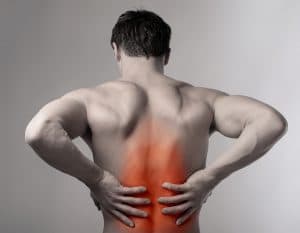Pain in the middle region of the back is among the most common. It can be chronic pain which means it is suffered on a regular and routine basis, or it can be acute which is to suddenly suffer severe pain. There are treatments and strategies for dealing with this pain.
 Common Causes of Middle Back Pain
Common Causes of Middle Back Pain
Injuries are a common cause of this pain. If someone irritates or strains muscles in the region, this can lead to pain. Car crashes or falls from a ladder can cause fractured vertebrae. This can limit movement.
Growing old leads to physical deterioration and in turn, can cause maladies that lead to back pain. Osteoporosis is among the maladies that can occur. Scoliosis and other spinal conditions can lead to chronic back issues. If nerves or ligaments are damaged it can lead to back pain. Anyone who is suffering from bad posture, fatigue, or muscle spasms can experience middle back pain. If someone sleeps on a mattress that is too soft, it might lead to temporary or chronic pain.
Pain in the region of the middle back may also be accompanied by anxiety and depression. Many people become very stressed when dealing with daily pain if they don't have an effective way to manage it.
Non-Surgical Pain Treatment Options
Stress, a nonactive lifestyle, obesity and even smoking can contribute to pain in the middle back. Anyone suffering from this type of pain should begin to start keeping a journal of the times and situations pain occurs. This can help effectively diagnose the problem and make a plan to treat or manage the pain. Numbing certain nerves is one way of isolating what specifically is causing the problem which helps assess the proper treatment. An MRI or CT scan might also be recommended.
Massage And Physical Therapy
Some causes of back pain respond very well to massage or other forms of physical therapy. If this is not enough it might be necessary to have minimally invasive surgery which requires only a tiny incision be made. This leaves only slight scarring and very little blood loss.
Traditional surgery makes a larger incision, often requires blood transfusions and considerably more recovery time. It may also leave much greater scarring. Because of this, traditional surgery should be used only as a last resort. The other methods are very often successful at treating many causes of this condition.
It is important to recognize the seriousness of this condition. Chronic and severe pain over time can lead to clinical depression and the lowering of one's quality of life. It can easily lead the one suffering from this condition to no longer be able to do the things they love.
Delaying diagnosis and treatment can lead to more permanent problems. Early treatment can often be key to reducing symptoms and getting the one suffering on a path to recovery with an effective plan to manage the pain.
Once someone realizes they are experiencing this pain, they should seek professional help. There are many options and the one that will work best depends on the specifics of each persons pain.

Leave a Reply